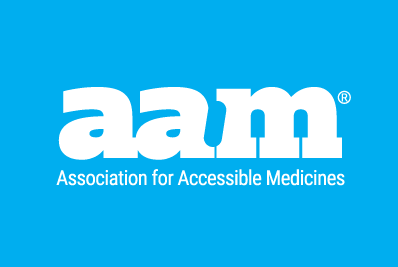AAM Opposes Legislation That Conflicts with Federal Law and Delays Patient Access to More Affordable Medicine
Oregon SB 764 Would Delay Patient Access to Lower-Cost Generic and Biosimilar Medicines
- Patent settlements expedite access to lower-cost life-saving generic and biosimilar medicines for patients and ensure continued investment to bring these affordable medicines to market. A study by IMS Health found patent settlements led to savings of more than $11 billion.1
- These settlements have taken years—if not decades—off the patent term for many drugs, including blockbusters. Significantly, IMS found that settlements led to generic drugs being introduced, on average, 81 months (6.75 years) prior to patent expiry.2
- This pro-patient result—generic or biosimilar entry long before patent expiration—is frequently not achievable through litigating a case to judgment. Brand companies frequently prevail in patent litigation. Settlement is often the only way to provide timely market entry for lower-priced generic and biosimilar medicines.3
- As representatives explained in the California litigation, generic and biosimilar companies will not take on the time and expense of developing products and challenging brand drug patents without the ability to settle. The inevitable result of taking patent settlements off the table will be fewer generic and biosimilar application filings and fewer patent challenges. Instead, companies will wait until patent expiration to bring products to market. Ultimately, this delays patient access to more affordable medicines.
- The cost of clinical trials for biosimilars alone is in the $17-35M range.
- It is much less likely that generics and biosimilars will take on both the large upfront development cost and litigation costs for generics and biosimilars if significant burdens (and a potential $10 million minimum penalty) are placed on settlements.
- Moreover, SB 764 likely is not limited to settlements between brand and generic drugs. SB 764 could also apply to settlements involving drugs seeking approval under Hatch-Waxman’s other abbreviated pathway for approval.4
SB 764 Would Benefit Brand-Name Pharmaceutical Companies and Ultimately Lead to Higher Drug Prices
- Brand drug companies are increasingly building larger and larger patent thickets around some of the highest-priced drugs in the world. For example, AbbVie has secured more than 100 patents on Humira®—many were issued after AbbVie’s initially compound patent expired—each designed to
make it difficult for another company to replicate the drug without using processes and techniques to which the pharma giant continues to hold rights.
5 - Patent settlements avoid costly and protracted litigation necessary to fight patent system abuses. Patent settlements frequently are the only pro-competitive and economical way to achieve early generic and biosimilar market entry in the face of patent thickets. Due to patent settlements, biosimilars of Humira® will enter the market 11 years before patent expiration.
- Restricting parties’ ability to settle litigation on mutually beneficial terms would have the unintended consequence of helping brand pharmaceutical companies—the same companies that caused the current drug pricing crisis.
- AAM members have continued to encounter difficulties in settling cases in light of California’s law (AB 824) and proposed federal patent settlement legislation. Citing the new legislation, brand companies are either resisting settlement or attempting to make settlement negotiations prohibitively one-sided.
- Absent settlements providing for early generic and biosimilar entry, there will be less competition, and brand prices will continue to stay higher for longer.
SB 764 Is Unnecessary Because There Is Already a Federal Framework in Place That Is Working Well
- There is an extensive federal framework for assessing patent settlement agreements. Today, the FTC reviews Hatch-Waxman and BPCIA settlements, and brings enforcement actions when appropriate. A separate—and inconsistent—state framework is unnecessary, especially when the federal system is working extremely well.
- According to recent FTC statistics, patent settlement
agreements using [the types of terms that [the Supreme Court] deemed problematic] decline[d] to [the] lowest level in 15 years.
Additionally, the FTC candidly conceded that[t]he data are clear: the Supreme Court’s Actavis decision has significantly reduced the kinds of reverse payment agreements that are most likely to impede generic entry and harm consumers.
6 - The FTC’s latest report further confirms this trend. As FTC stated in its press release,
Despite the high number of settlements, those that include the types of reverse payments that are likely to be anticompetitive remain very low.
7
SB 764 Would Even Prohibit Settlement Agreements Between Competing Drug Products More Broadly
- SB 764 likely also would prohibit pro-competitive settlements between competing drugs other than generics, further underscoring its harmful effects.
- In a patent infringement suit between two products that are both protected by IP, both parties may allege that the other has infringed its patent. Settling such a dispute often involves the parties granting each other cross-licenses to their patents. Such settlements can significantly increase competition between the two products, to the benefit of consumers, because consumers get access to both therapies, rather than just the winner and not the loser.
- However, SB 764 likely would prohibit many such settlements in the same way it prohibits brand/generic settlement, because those brand/brand settlements may well involve an exchange of exclusive licenses or some other
tangible or intangible
item of value. - Courts already have recognized that state patent settlement legislation like SB 764 that seeks to: (ⅰ) regulate patent settlements completed outside of the state’s borders; (ⅱ) impose a more stringent substantive standard than the federal Actavis test; or (ⅲ) impose unreasonable penalties on individuals is likely unconstitutional.
- California recently enacted legislation (AB 824) that is similar to SB 764 in relevant respects.
- The Eastern District of California recently held that AB 824 likely was unconstitutional as applied to out-of-state conduct, explaining that:
- California
would likely violate the Dormant Commerce Clause
if the Attorney General were to enforce the terms of AB 824 against two out of state parties that entered into a settlement agreement outside of California.
8 - State patent settlement legislation that
stifle[s] the creation, production, and entry onto the market of cheaper generic medications
likely wouldconflict with, and therefore [be] preempted by, the Hatch-Waxman Act.
9 - California’s $20 million minimum fine likely violates the Eighth Amendment Excessive Fines Clause
as applied to individuals.
10
- California
- Although the Eastern District’s decision was vacated on procedural grounds (and has since been re-filed), this aspect of its merits analysis still holds.
- SB 764 suffers from these same constitutional defects: It applies to settlements with no nexus to Oregon, is fundamentally at odds with the Supreme Court’s Actavis decision and the Hatch-Waxman Act and imposes excessive fines on individuals (a minimum of $10 million).
- If Oregon were to enact SB 764 in its current form, the statute likely will be struck down—and, at the very least, Oregon likely will be tied up in court challenges for several years.
References
- IMS Institute for Healthcare Informatics, Impact of Patent Settlements on Drug Costs: Estimation of Savings 6 (June 2013).
- Id. at 4.
- For example, Lex-Machina, Hatch-Waxman/ANDA Litigation Report 2017, Legal Defenses and Outcomes in Paragraph IV Patent Litigation; Gregory Glass, Legal Defenses and Outcomes in Paragraph IV Patent Litigation, 10 J. Generic Meds. 4, 7-8 (2013).
- 21 U.S.C. § 355(b)(2).
- Cynthia Koons, Bloomberg Businessweek, September 2017. This Shield of Patents Protects the World’s Best-Selling Drug.
- Federal Trade Commission, May 23, 2019. FTC Staff Issues FY 2016 Report on Branded Drug Firms’ Patent Settlements with Generic Competitors
- Federal Trade Commission, December 3, 2020. FTC Staff Issues FY 2017 Report on Branded Drug Firms’ Patent Settlements with Generic Competitors
- AAM v. Becerra, No. 2:19-cv-02281-TLN-DB, 2019 WL 7370421, at *5 (E.D. Cal. Dec. 31, 2019).
- Id. at 7.
- Id. at 10.

